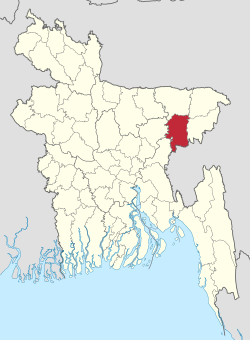Habiganj
|
Habiganj হবিগঞ্জ |
|
|---|---|
| District | |
 Location of Habiganj in Bangladesh |
|
| Country |
|
| Division | Sylhet Division |
| Area | |
| • Total | 2,636.59 km2 (1,017.99 sq mi) |
| Demonym(s) | Habiganji |
| Time zone | BST (UTC+6) |
| Postal code | 3330-3374 |
| Website | www |
Habiganj (হবিগঞ্জ Hobigônj), formerly Habibganj, which was named after its founder, Syed Habib Ullah of Taraf fiefdom, is a district in the north-eastern part of Bangladesh. Between and thirteenth and early seventeenth centuries, Habiganj was part of the state of Nasirabad, which was established by Sipahisalar Syed Nasiruddin with its capital at Murarband Darbar Sharif, Taraf. At present, it is a district of Sylhet Division.
With the passage of time, Habibganj turned into Habiganj. During the British Raj, Habiganj was established as a Thana (police precinct) in 1790, under Dhaka district (1779–1793). Until 1896, Habiganj's administrative centre was in Court Andar, Laskarpur. On 12 September 1874 it came under Sylhet district (part of Assam). Habiganj was declared as subdivision in 1867. On 7 April 1893, according to Notification #273 of Assam Provincial Government, Habiganj Thana (Administrative unit) was established. Habiganj was rejoined with East-Bengal (now Bangladesh) in 1911. Then the Office of the Circle Officer (Development) was established in 1960. On 1 March 1984 Habiganj was established as a District.Sheikh Liaquat Ali is the current chairman of Habiganj.
At present Habiganj consists of 8 upazilas, 6 municipalities, 36 wards, 77 union parishads, 124 mahallas, 1241 mouzas and 2076 villages.
All the reported prehistoric records of Bangladesh are associated with the Lalmai hills and the higher areas of Sylhet, Habiganj, and Chittagong and Madhupur tract. The prehistoric site of Chaklapunji tea garden, near Chandirmazar of Chunarughat. Habiganj has also revealed a significant number of prehistoric tools from the bed of a small ephemeral stream (water remains here only for a few hours after rainfall) known as Balu nadi (river). Angularity and freshness of the fossil wood artifacts suggest that they did not come from a great distance and probably came from nearby hillocks. Typologically, technologically, and morphometrically, the artifacts are more or less the same as those found in the Lalmai area. The Fossil wood assemblages of Lalmai and Chaklapunji can be classified into two groups:
...
Wikipedia
